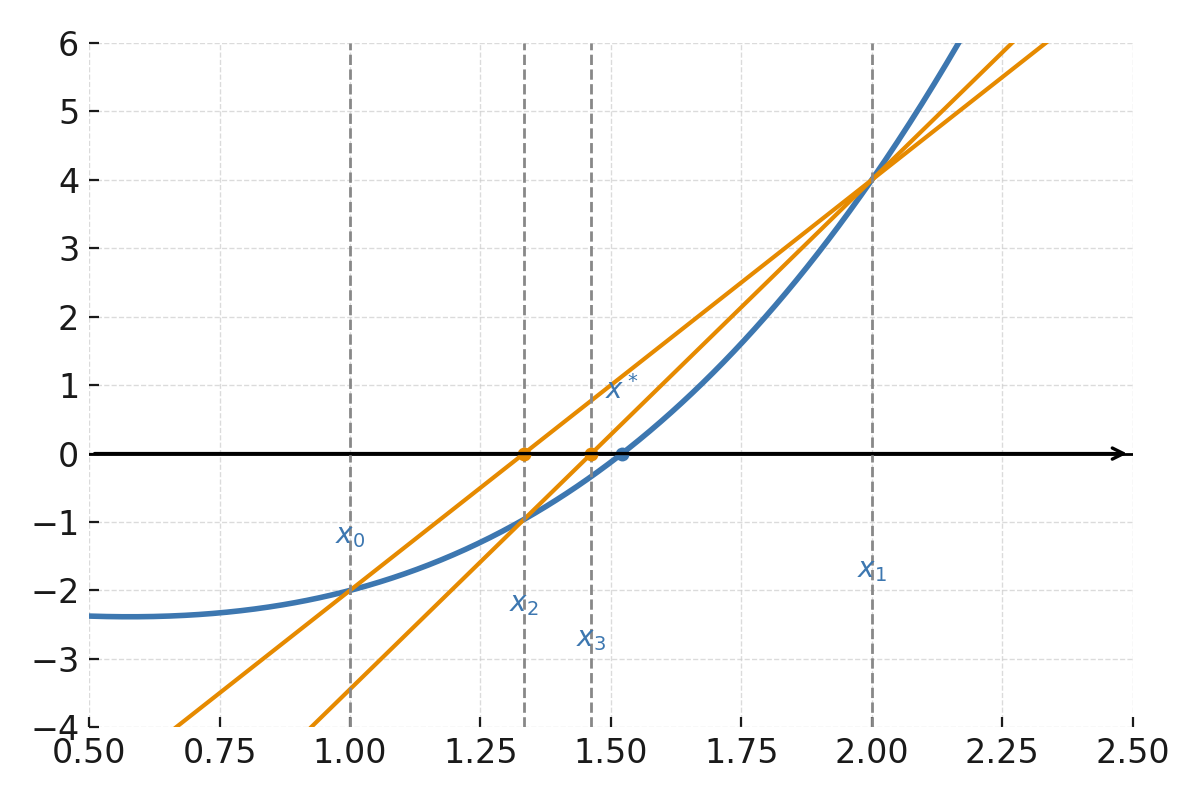Secant method
The secant method is a numerical technique for finding a root of a function, that is, a point where \( \large f(x) = 0 \). It resembles the Newton-Raphson method, but instead of using the derivative \( \large f'(x) \), the tangent is replaced by a secant through two points on the graph.
The idea behind the method
At each step, the two most recent points \( \large (x_{n-1}, f(x_{n-1})) \) and \( \large (x_n, f(x_n)) \) are used to form a straight line (secant). The intersection of this secant with the x-axis is used as the new estimate \( \large x_{n+1} \). The method is repeated until two successive estimates are very close.
Formula
$$ \large x_{n+1} = x_n - f(x_n) \cdot \frac{x_n - x_{n-1}}{f(x_n) - f(x_{n-1})} $$
Step-by-step procedure
- Choose two starting values \( \large x_0 \) and \( \large x_1 \), where the function has opposite signs.
- Compute \( \large f(x_0) \) and \( \large f(x_1) \).
- Use the formula to find \( \large x_2 \).
- Repeat the calculation so that \( \large x_{n+1} \) is found using the two most recent points \( \large x_n \) and \( \large x_{n-1} \).
- Stop when \( \large |x_{n+1} - x_n| < \varepsilon \).
Example
We seek the root of \( \large f(x) = x^3 - x - 2 \).
Choose \( \large x_0 = 1 \) and \( \large x_1 = 2 \).
$$ \large f(1) = -2, \quad f(2) = 4 $$
$$ \large x_2 = 2 - 4 \cdot \frac{2 - 1}{4 - (-2)} $$
$$ \large x_2 = 2 - 4 \cdot \frac{1}{6} $$
$$ \large x_2 = 1{,}333 $$
The new point \( \large x_2 = 1{,}333 \) is used together with \( \large x_1 = 2 \) to calculate the next value:
$$ \large x_3 = 1{,}333 - f(1{,}333) \cdot \frac{1{,}333 - 2}{f(1{,}333) - f(2)} $$
After a few iterations, a root is obtained \( \large x \approx 1{,}521 \), the same result as with Newton-Raphson, but without knowing the derivative of the function.

The function \( \large f(x) = x^3 - x - 2 \).
The points \( \large (x_0, f(x_0)) \) and \( \large (x_1, f(x_1)) \) are connected by a secant that intersects the x-axis at \( \large x_2 \). Then, a new secant is drawn between \( \large (x_1, f(x_1)) \) and \( \large (x_2, f(x_2)) \), which intersects the axis even closer to the root.
Remarks
The secant method converges faster than the bisection method but slower than Newton-Raphson. However, it is often a good compromise because it does not require calculating the derivative of the function.